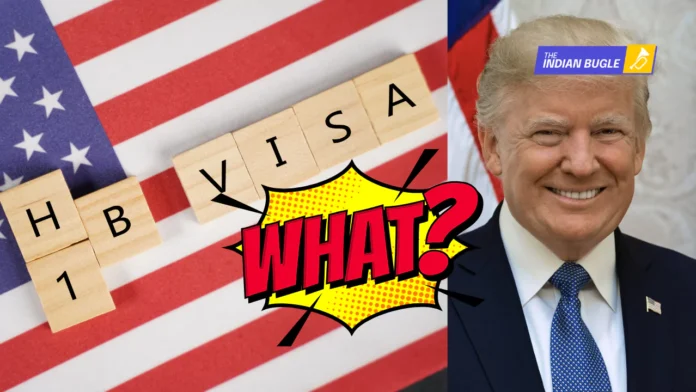The H-1B visa has long been a gateway for skilled professionals—especially Indians—seeking opportunities in the United States. For decades, it symbolised the “American Dream”: a chance to work in Silicon Valley, contribute to innovation, and build a better life. That dream, however, just became much more expensive.
In a move that stunned both businesses and workers, President Donald Trump has announced a $100,000 annual fee on most new H-1B visa applications. The policy, effective September 21, 2025, represents one of the most significant shifts in U.S. immigration rules in years, and its ripple effects will be felt most sharply in India, home to the majority of H-1B recipients.
What the New Rule Means
Under the new proclamation, U.S. companies filing H-1B petitions for employees outside America must pay a $100,000 fee with each application. Without payment, the petition will be denied unless it qualifies for a “national interest” exemption.
This rule is slated to last 12 months initially, with the possibility of extension. It comes alongside other measures such as raising prevailing wage levels for foreign workers and stricter scrutiny of outsourcing firms. For context, current H-1B application costs typically run into a few thousand dollars. A sudden jump to $100,000 is nothing short of a shockwave for the system.
Why Indians Are at the Center of the Storm
Indians are the single largest group of H-1B visa holders, consistently accounting for more than two-thirds of approvals. Every year, tens of thousands of Indian engineers, developers, and scientists move to the U.S. under this program.
For them, the new fee is not just a bureaucratic hurdle—it’s a financial barrier that could make pursuing opportunities in the U.S. nearly impossible without corporate backing. Large tech firms may be able to absorb these costs for critical hires, but mid-sized companies, startups, and consulting firms may struggle, reducing the number of opportunities available to Indian professionals.
Indian IT services companies, which rely heavily on deploying skilled workers to client sites in the U.S., could see their cost structures upended. A $100,000 charge per application could make the traditional outsourcing model unviable.
Immediate Fallout
The announcement has triggered a rush among H-1B and H-4 visa holders currently outside the U.S. Many employers have advised their staff to return before September 21 to avoid falling under the new regime. Similarly, employees already in the U.S. have been asked to avoid unnecessary travel abroad, fearing they may be forced into reapplying under the new fee structure.
On the stock markets, shares of several IT majors dipped following the news, as investors braced for the impact on earnings. For Indian families, the uncertainty is more personal: career plans, schooling, and even green card timelines suddenly look less predictable.
Reactions Across Stakeholders
The decision has sparked strong reactions across industry, politics, and policy circles.
- Corporate America fears that talent pipelines will be disrupted, with innovation ecosystems in Silicon Valley and beyond losing access to skilled workers.
- Indian industry leaders argue the move could accelerate the shift of R&D labs, startups, and patents out of the U.S. and back to India or other global hubs.
- Lawmakers and immigration advocates question the legality of imposing such a high fee without congressional approval, and lawsuits challenging the policy are likely.
On the other hand, supporters of the measure frame it as a step toward protecting U.S. jobs and ensuring that employers hire more Americans at competitive wages.
What This Means for Indian Professionals
For many Indian tech workers, the implications are sobering:
- Cost of mobility: Traveling outside the U.S. could now trigger a re-entry application under the new rules, effectively locking many into staying stateside.
- Career hurdles: Early-career professionals may see opportunities dry up as employers scale back sponsorships.
- Uncertain futures: Those on the H-1B path to a green card face greater financial and professional risk.
Some Indians may now look more seriously at alternatives such as Canada, the UK, or Australia, which have more welcoming skilled migration pathways. Others may pivot toward remote work for U.S. firms while staying in India, a trend that accelerated during the pandemic and could gain new traction under these conditions.
A Silver Lining for India?
While the fee hike is a blow for individuals, some analysts suggest it could become an opportunity for India. If talent finds it harder to move abroad, companies may increasingly set up operations in Bengaluru, Hyderabad, or Gurugram rather than Silicon Valley. This could mean more innovation, startups, and intellectual property creation happening on Indian soil.
However, capitalising on this shift will require strong domestic policy support—investment in infrastructure, streamlined regulations, and a nurturing environment for research and entrepreneurship.
Looking Ahead
The $100,000 H-1B fee represents more than just a policy tweak; it’s a redefinition of America’s approach to skilled immigration. For decades, the U.S. has been the default destination for India’s best and brightest. That equation is now being tested.
If the measure endures beyond its initial 12-month window, it could permanently alter migration flows, redirecting talent and investment to other countries. If challenged successfully in courts or revisited by future administrations, it may instead go down as a short-lived but disruptive experiment.
Conclusion
The American Dream is not dead for Indians, but it now carries a price tag large enough to reshape aspirations. For some, it will remain worth paying; for others, the “fee” may push them to look elsewhere. What is certain is that this change has forced both India and the U.S. to rethink the future of global talent, innovation, and opportunity.
The real question is whether America’s gain in job protection will outweigh its loss in global competitiveness—or whether, in the long run, this will be remembered as the moment the American Dream became the American Fee.
